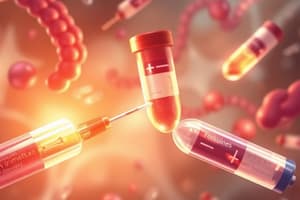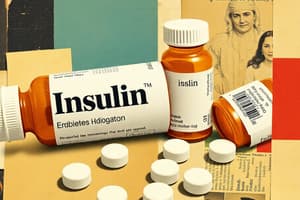Podcast
Questions and Answers
A patient with type 1 diabetes mellitus (T1DM) is prescribed insulin. What is the primary reason insulin is a necessary treatment for individuals with T1DM?
A patient with type 1 diabetes mellitus (T1DM) is prescribed insulin. What is the primary reason insulin is a necessary treatment for individuals with T1DM?
- To supplement the inadequate insulin production resulting from autoimmune destruction of beta cells. (correct)
- To enhance the sensitivity of peripheral tissues to endogenous insulin.
- To counteract the effects of insulin resistance commonly associated with T1DM.
- To stimulate the pancreas to regenerate functional beta cells.
Consider a patient experiencing a hypoglycemic episode. Following the administration of 15g of rapid-acting carbohydrates, what is the most critical next step in managing this patient's condition?
Consider a patient experiencing a hypoglycemic episode. Following the administration of 15g of rapid-acting carbohydrates, what is the most critical next step in managing this patient's condition?
- Providing a high-fat snack to sustain blood glucose levels.
- Administering a bolus of long-acting insulin to prevent rebound hyperglycemia.
- Rechecking the patient's blood glucose level after 15 minutes. (correct)
- Initiating continuous glucose monitoring for the next 24 hours.
In the context of nursing education for diabetic patients, what is the most crucial instruction regarding foot care practices that should be emphasized to mitigate the risk of complications?
In the context of nursing education for diabetic patients, what is the most crucial instruction regarding foot care practices that should be emphasized to mitigate the risk of complications?
- Soaking feet in warm water with Epsom salts daily to enhance circulation.
- Inspecting feet daily for any signs of injury, lesions, or abnormalities. (correct)
- Trimming toenails in a rounded shape to prevent ingrown toenails.
- Applying moisturizing lotion between the toes to prevent dryness and cracking.
When educating a patient on the use of long-acting insulin, such as insulin glargine (Lantus) or insulin detemir (Levemir), what crucial instruction should be provided to ensure optimal therapeutic outcomes?
When educating a patient on the use of long-acting insulin, such as insulin glargine (Lantus) or insulin detemir (Levemir), what crucial instruction should be provided to ensure optimal therapeutic outcomes?
For a patient prescribed intermediate-acting insulin (NPH), such as Humulin N or Novolin N, what is the most important instruction regarding its administration?
For a patient prescribed intermediate-acting insulin (NPH), such as Humulin N or Novolin N, what is the most important instruction regarding its administration?
What is the primary advantage of rapid-acting insulin analogs, such as insulin lispro (Humalog), insulin aspart (NovoLog), or insulin glulisine (Apidra), compared to regular insulin?
What is the primary advantage of rapid-acting insulin analogs, such as insulin lispro (Humalog), insulin aspart (NovoLog), or insulin glulisine (Apidra), compared to regular insulin?
A patient newly diagnosed with type 2 diabetes mellitus (T2DM) is prescribed oral medications and lifestyle modifications. What is the underlying mechanism driving the pathophysiology of T2DM that necessitates this treatment approach?
A patient newly diagnosed with type 2 diabetes mellitus (T2DM) is prescribed oral medications and lifestyle modifications. What is the underlying mechanism driving the pathophysiology of T2DM that necessitates this treatment approach?
In the management of diabetes, what is the rationale behind instructing patients to monitor their blood glucose levels regularly?
In the management of diabetes, what is the rationale behind instructing patients to monitor their blood glucose levels regularly?
Which statement accurately describes the primary difference between type 1 diabetes (T1DM) and type 2 diabetes (T2DM)?
Which statement accurately describes the primary difference between type 1 diabetes (T1DM) and type 2 diabetes (T2DM)?
What is the rationale behind advising patients with diabetes to carry a source of rapid-acting carbohydrates with them at all times?
What is the rationale behind advising patients with diabetes to carry a source of rapid-acting carbohydrates with them at all times?
A patient with diabetes is admitted to the hospital with diabetic ketoacidosis (DKA). Which nursing intervention is most critical in the initial management of this patient's condition?
A patient with diabetes is admitted to the hospital with diabetic ketoacidosis (DKA). Which nursing intervention is most critical in the initial management of this patient's condition?
Following a diagnosis of gestational diabetes mellitus (GDM), which treatment strategy is typically recommended as the first line of management?
Following a diagnosis of gestational diabetes mellitus (GDM), which treatment strategy is typically recommended as the first line of management?
A patient with diabetes is scheduled to undergo surgery. What is the most crucial consideration regarding their insulin management during the perioperative period?
A patient with diabetes is scheduled to undergo surgery. What is the most crucial consideration regarding their insulin management during the perioperative period?
What is the primary goal of carbohydrate counting in diabetes management?
What is the primary goal of carbohydrate counting in diabetes management?
Which instruction is most crucial when educating a patient about sick day rules for diabetes management?
Which instruction is most crucial when educating a patient about sick day rules for diabetes management?
What is the rationale behind teaching patients with diabetes to inspect their feet daily?
What is the rationale behind teaching patients with diabetes to inspect their feet daily?
When administering short-acting insulin (e.g., Regular insulin) intravenously, what is the most critical factor to consider regarding its onset and duration of action?
When administering short-acting insulin (e.g., Regular insulin) intravenously, what is the most critical factor to consider regarding its onset and duration of action?
Which statement accurately describes the relationship between exercise and insulin sensitivity in individuals with diabetes?
Which statement accurately describes the relationship between exercise and insulin sensitivity in individuals with diabetes?
For a patient with diabetes who reports frequent episodes of hypoglycemia, what is the most important assessment to conduct to identify potential contributing factors?
For a patient with diabetes who reports frequent episodes of hypoglycemia, what is the most important assessment to conduct to identify potential contributing factors?
What is the rationale for routinely monitoring kidney function in individuals with diabetes?
What is the rationale for routinely monitoring kidney function in individuals with diabetes?
Flashcards
Rapid-Acting Insulin
Rapid-Acting Insulin
Insulin lispro, aspart, and glulisine; Onset: 10-15 mins; Peak: 1-2 hrs; Duration: 3-5 hrs. Take before meals.
Short-Acting Insulin
Short-Acting Insulin
Regular insulin (Humulin R, Novolin R); Onset: 30-60 mins; Peak: 2-4 hrs; Duration: 5-8 hrs. Used IV/SC, 30 mins before meals.
Intermediate-Acting Insulin
Intermediate-Acting Insulin
NPH insulin (Humulin N, Novolin N); Onset: 1-2 hrs; Peak: 4-12 hrs; Duration: 12-18 hrs. Cloudy, roll to mix, often BID.
Long-Acting Insulin
Long-Acting Insulin
Signup and view all the flashcards
Type 1 Diabetes (T1DM)
Type 1 Diabetes (T1DM)
Signup and view all the flashcards
Type 2 Diabetes (T2DM)
Type 2 Diabetes (T2DM)
Signup and view all the flashcards
Gestational Diabetes (GDM)
Gestational Diabetes (GDM)
Signup and view all the flashcards
Diabetes Assessment
Diabetes Assessment
Signup and view all the flashcards
Diabetes Medications Teaching
Diabetes Medications Teaching
Signup and view all the flashcards
Diabetes Nutrition
Diabetes Nutrition
Signup and view all the flashcards
Hypoglycemia Treatment
Hypoglycemia Treatment
Signup and view all the flashcards
DKA/HHS Interventions
DKA/HHS Interventions
Signup and view all the flashcards
Diabetes Education Topics
Diabetes Education Topics
Signup and view all the flashcards
Patient Teaching: Self-Care
Patient Teaching: Self-Care
Signup and view all the flashcards
Diabetes Complications
Diabetes Complications
Signup and view all the flashcards
Study Notes
Types of Insulin
- Rapid-acting insulin includes insulin lispro (Humalog), insulin aspart (NovoLog), and insulin glulisine (Apidra)
- Rapid-acting insulin has an onset of 10-15 minutes, a peak of 1-2 hours, and a duration of 3-5 hours
- It's important to take rapid-acting insulin before meals and monitor for hypoglycemia
- Short-acting insulin includes regular insulin (Humulin R, Novolin R)
- Short-acting insulin has an onset of 30-60 minutes, a peak of 2-4 hours, and a duration of 5-8 hours
- Short-acting insulin can be administered intravenously or subcutaneously 30 minutes before meals
- Intermediate-acting insulin includes NPH insulin (Humulin N, Novolin N)
- Intermediate-acting insulin has an onset of 1-2 hours, a peak of 4-12 hours, and a duration of 12-18 hours
- NPH insulin is cloudy and should be rolled to mix; it's often taken twice daily (BID)
- Long-acting insulin includes insulin glargine (Lantus) and insulin detemir (Levemir)
- Long-acting insulin has an onset of 1-2 hours, a minimal peak, and a duration of approximately 24 hours
- Long-acting insulin should not be mixed and should be taken at the same time daily
Types of Diabetes
- Type 1 diabetes (T1DM) is caused by autoimmune beta-cell destruction
- Treatment for T1DM involves lifelong insulin, carbohydrate counting, and blood glucose monitoring
- Type 2 diabetes (T2DM) is caused by insulin resistance and beta-cell dysfunction
- Risk factors for T2DM include obesity, sedentary lifestyle, and family history
- Treatment for T2DM includes lifestyle changes, oral medications, and insulin as needed
- Gestational diabetes (GDM) is caused by hormonal insulin resistance during pregnancy
- Treatment for GDM includes diet, exercise, and insulin if needed
- Other specific types of diabetes include MODY, LADA, and those caused by secondary factors like steroids or pancreatitis
Nursing Care for Diabetes
- Assessment involves monitoring blood glucose, assessing symptoms, and reviewing adherence to treatment plans
- Nursing interventions include teaching proper medication use and awareness of side effects
- Nutritional interventions involve carbohydrate counting and following a balanced diet
- Encouraging exercise and monitoring blood glucose levels are important interventions
- Treat hypoglycemia with 15g of carbohydrates and recheck blood glucose in 15 minutes
- DKA/HHS management involves monitoring hydration and administering insulin/fluids
- Education includes monitoring techniques, sick day rules, and foot care
Patient Teaching
- Daily foot inspections, understanding sick day insulin use, and recognizing warning signs are important
- Complications of diabetes can include eye, kidney, nerve, and cardiovascular diseases
Studying That Suits You
Use AI to generate personalized quizzes and flashcards to suit your learning preferences.




